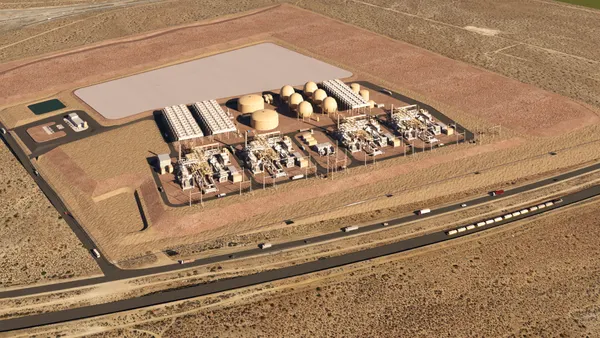Dive Brief:
- The price of lithium-ion batteries is declining faster than anticipated, causing Bloomberg New Energy Finance (BNEF) to significantly increase its forecast for global deployment energy storage, both behind-the-meter and grid-scale.
- BNEF now believes the global energy storage market, which excludes pumped hydro, will grow to a cumulative 942 GW / 2,857 GWh by 2040, "attracting $620 billion in investment over the next 22 years."
- By 2040, BNEF expects storage will represent 7% of the total installed power capacity globally. And while most storage capacity is now utility-scale, the firm expects that in the mid-2030s behind-the-meter storage will dominate deployments.
Dive Insight:
BNEF ramped up its energy storage forecasts, concluding that as prices for batteries fall they will make sense in many more situations: from providing energy in remote locations, to the granular grid control needed to integrate renewables and electric vehicles in urban settings.
In 2016, BNEF forecast the energy storage market could be valued at $250 billion or more by 2040 with 25 GW of the devices deployed by 2028. Last year, the firm predicted storage capacity rising to a total of 125 gigawatts/305 gigawatt-hours by 2030.
The firm's most-recent "Long-Term Energy Storage Outlook" predicts the capital cost of utility-scale lithium-ion battery systems will decline 52% between 2018 and 2030. And the firm notes, that is "on top of the steep declines seen earlier this decade. This will transform the economic case for batteries in both the vehicle and the electricity sector."
And as battery prices decline and the technology matures, BNEF sees a shift away from utility-scale installations and instead, more focus on aggregation.
"The majority of storage capacity will be utility-scale until the mid-2030s, when behind the meter applications overtake," Logan Goldie-Scot, head of energy storage at BNEF, said in a statement.
BNEF predicts that by 2040, nine markets will represent two-thirds of the installed global capacity: China, the United States, India, Japan, Germany, France, Australia, South Korea and the U.K. While China is expected to lead installations throughout the 2040s, South Korea is expected to dominate today's market. The U.S. will lead in the early 2020s, BNEF believes, before it is overtaken by China later in the decade.
Africa will see rapid growth as prices decline and utilities "recognize increasingly that isolated assets combining solar, diesel and batteries are cheaper in far flung sites than either an extension of the main grid or a fossil-only generator," the report says.
BloombergNEF recently issued a correction on the dollar investment figure. This post has been updated to reflect that change.













